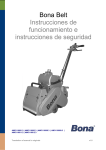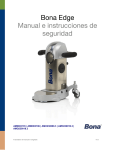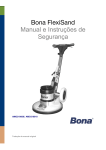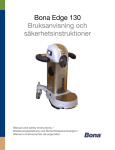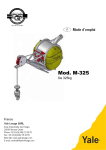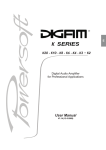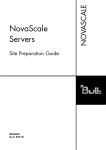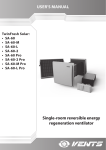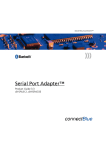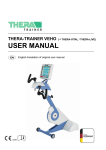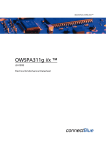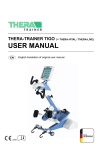Download Bona Belt Manual (eng)
Transcript
Bona Belt Operating instructions and safety instructions AMO110001.3 | AMO110003.3 | AMO110008.3 | AMO110009.3 | AMO110011.3 | AMO110012.3 Translation of manual in originals v1.0 Bona Belt Index 1. Technical data 3 2. Safety instructions 3 3. Repairs, Service and Maintenance a. Service b. Spare parts and exploded views 6 6 6 4. Warranty 7 5. Assembly a. Assembling a new machine 8 8 6. Starting a. Start instructions for motor 1-phase 2.2 kW 230V 50 Hz (EU) b. Start instructions for motor 1-phase 3.0 kW 230V 60 Hz (USA) 8 8 8 7. The machine’s field of application: 9 8. Usage technique a. Regulating drum pressure b. Changing sanding belt c. Adjusting the sanding belt d. Setting the drum level e. Setting the height of the handle shaft f. Changing the sanding drum g. Emptying the dust bag h. Dismantling the machine 9 9 10 10 11 11 12 12 12 9. Periodic maintenance 13 10. In the event of faults 14 11. Safety regulations when using Bona Belt 15 12. EU assurance of conformity 17 2 Bona Belt TECHNICAL DATA Machine: Motor type: Voltage (+/- 10%): Frequency: Power: Rated current: Recommended fuses: Insulation class: Protection class: Weight machine frame: Weight motor: Condensers: Drum width: Hour counter Total weight: Dust emissions: Format sanding belt: EU 1 phase 230V 50 Hz 2.2 kW 12.9A Class C 16A F IP54 Approx 1750 per min normal load 48 kg 23.5 kg Start 25 μF, operation 50 μF 250 mm, alt. 200 mm 99 999 hours 74 kg 3 < 2 mg/m air. 250 x 750 mm or 200 x 750 mm USA 1 phase 230V 60 Hz 3.0 kW/ 4.5HP 30A 30A F IP54 Approx 2300 per min normal load 105.8 lbs. 51.81 lbs. Start 50 μF, operation 80 μF 8” alt. 10” 99 999 hours 163.1 lbs. 3 < 2 mg/m air. Height/Width/Length 1000mm/360mm/960mm 39,37”/14,17”/37,8” Abrasive drum speed: 9-7/8”x29” alternatively 7-7/8”x29” Noise measurement according to SS-EN ISO 3746:1995 & SS-EN ISO 11202:1995: Idle Abrasive 60 Noise level: 85,6 dB(A) Calculated sound effect: 96,9 dB Vibration measurements according to SS-EN ISO 5349-2:2001: X Y Z Vibrations RMS (m/s²) 0,5 0,4 0,8 Vibrationsr vektorsumma (m/s²) 1,0 X 0,6 Y 0,4 0,9 Abrasive 100 82,8 dB(A) 93 dB Z 0,6 X 0,6 Y 0,3 0,8 Z 0,5 According to used standard SS-EN ISO 3746:1995 is the maximum standard deviation of reproducibility 3dB, defined in ISO 7574-1 . According to Swedish Work Environment Authority the measure uncertainty at vibrations measurements estimated to 20-40%. The thing that contributes to the measuring uncertainty is the transfer of vibrations to the accelerometer. We congratulate you on your choice of a new Bona Belt floor sanding machine. Carefully read through the entire user manual before you begin working with the machine. If anything is unclear, turn to your reseller with confidence or to Bona AB. Safety instructions Read through the safety instructions carefully and inform your employees and users, so no one comes to harm when using the machine. Then save the instructions! The manufacturer is not liable for personal injury or machine damage due to incorrect operation of the machine! The machine is only built for sanding of wooden floors! The machine may only be used by authorised persons that have been trained in its function. Voltage: Make sure the voltage stated on the machine’s rating plate corresponds to the voltage in the power outlet before you start the machine. NOTE! It is obligatory to read and understand the user manual before the machine is used. 3 Bona Belt DANGER means that you or other staff can suffer a serious injury or death if THE INSTRUCTIONS MARKED WITH DANGER ON THIS MACHINE OR IN THESE USER INSTRUCTIONS are ignored or are not followed. Read the entire user manual before you use the machine. WARNING means that you or other staff can suffer an injury if the instructions marked with WARNING on this machine or in this user manual are ignored or not followed. The machine or other property may also be damaged if instructions marked with WARNING are ignored. Under adverse conditions, a mixture of dust and air can be explosive. Sanding of wooden floors can create an environment that can be explosive. The safety routines below must be followed. Cigarette lighters, control lamps and all other sources of ignition can cause explosions if they are active during sanding. All sources of ignition should be extinguished or if possible removed completely from the work area. In work areas with poor ventilation, an explosive environment can occur if certain flammable materials, that is to say solvents, thinners, alcohol, fuel, certain polishes, wood dust and other flammable materials are in the atmosphere. Floor grinders can cause slightly flammable materials and vapours to burn. Read the manufacturer’s label on all chemicals to be used so that you can determine the flammability. Ensure that the work area always has good ventilation. Dispose of the contents in the dust bag when the bag is one-third full. After you have finished sanding, the dust bag must be empties and the contents must be stored in a safe place outdoors due to fire hazard. Never leave a dust bag containing sanding dust unattended. Never empty the contents in an open fire. Hitting a nail during sanding can produce sparks and cause explosion or fire. Always use a hammer to pound in any metal pieces before sanding the floor. Always keep a fire extinguisher (ABC-class or water) available. Use of a machine that is not complete or that is not fully mounted can result in personal injury or damage to property. Never use these machines before they are fully mounted. Ensure that all fastening devices are fixed. Make adjustment as per the machine specifications. NOTE! Never remove or disable the earth lead in the power cable. Consult an electrician if the earth lead is missing or if you suspect that your circuit is not properly earthed. There is a risk of electric shock if the machine is used in a circuit that breaks repeatedly or is under dimensioned. Allow an authorised electrician to control the fuse, breaker or the power supply. The operator or other persons present can be injured if the power to the machine is connected while maintenance is performed. Always remove the power cable to the machine from the power point. There is a risk of personal injury if the grinder runs over and damages the power cable. Ensure that the power cable does not come into contact with the sanding drum. Always lift the power cable over the machine and grind in a direction away from the power cable. Always use an earth fault breaker that breaks the current immediately in the event of a fault in the electrical system or in the extension power cable. In order to prevent unintentional start of the machine, the power cable must be removed when the machine is not used and during service. Use of the machine with a damaged power cable can cause electric shock. Do not pull the machine by the power cable. Movable parts of the machine can cause serious personal injury and/or material damage. Keep hands, feet and loosely fitting clothing away from all movable parts of the grinder. If a floor grinder is used without all protection covers in place it may lead to personal injury or material damage. The operator or other persons present can be injured if the power to the machine is connected while maintenance is performed, or while a tool is changed. 4 Bona Belt Because dust from sanding (i.e. red lead, certain types of wood and metals) are hazardous to health, a face mask of at least class P2 must be used. There is a risk of damage to the eyes and/or body if protective clothing and/or protective equipment is not used during sanding. Always use protective glasses, protective clothing, ear protection and a face mask of at least class P2 during sanding. Use ear protection Use face mask Read manual and safety instructions Dangerous High voltage Do not touch For minimized dust environment use a vacuum cleaner intended for wooden dust. The air flow on the vacuum cleaner should at least be 245m3/h. We strongly recommend Bona DCS system for best result. Store contained wooden dust outdoors in a safe place, due to the risk of fire. Never leave contained wooden dust without supervision. Always keep a fire extinguisher (ABC-class or water) available. Take precautionary measures to ensure that the machine is not damaged during transport. Be careful with power cables. Use the correct power cable with the correct length (see accessories list). Never carry the machine by the power cable. Never pull power cables from the machine or wall socket with strong movements. Protect the power cables against heat, oil and sharp edges. Power cables longer than 10m should not be used. Remove the power cable from the machine when it is not in use. Ensure that the machine does not start unintentionally. Never carry a connected machine. Ensure that the breaker is not on once the machine is connected to a power socket. Never use the machine if the start handle does not function as it should. Inspect the machine regularly. If you discover damaged parts, replace them at once. If necessary, contact the manufacturer, an authorised reseller or service partner. Note! Because of this construction is in many ways unique use of other spare parts and accessories than Bona original spare parts can cause a risk of personal injury and/or damage to the machine. Ensure that the machine is always in good condition. Keep the machine clean for better and safer use. Follow the instructions concerning the replacement of accessories. Inspect the power cables regularly. Repair or replace defective parts if they are damaged. Store the machine in a dry and locked area when not in use. Do not forget to put the on the tool before you start the machine. Always check that the sanding paper is correctly adjusted before you begin sanding. Keep the handle clean and free from grease. Keep unauthorised persons away from the work site. Do not allow unauthorised persons to come into contact with the machine or power cables. Do not misuse the machine. The machine works better when it is used according to its capacity and design. Allow the motor to “rest” during periods of heavier use. The motor will cool better, thus increasing its lifespan. Use fuses with the correct ampere number in relation to the motor. Never use a machine for anything else other than sanding, polishing and oiling of wooden floors. Service or repairs performed by unauthorised persons can cause damage or accidents. If service and repairs are performed by unauthorised persons, the warranty may become invalid. Service and repairs must be performed by Bona or retailers authorised by Bona. Be aware when you work. Use common sense. Do not use the machine if you are tired, have consumed alcohol or have taken medication that can affect your judgement or your body control. Due to the potential fire hazard involved with sanding dust, smoking is not permitted while sanding. Always use earth fault breaker! 5 Bona Belt Repairs, Service and Maintenance Service Bona Belt is a high quality machine and is tested by authorised test staff at the factory before delivery. However, electrical and mechanical parts wear down and age during long-term use. In order to keep the machine in a safe and functioning condition, service must be performed every 250 work hours or at least once a year. This service includes control of wheels, cable stand, motor, tension device, sanding drum and handle shaft function is controlled. Only Bona's original parts may be used because the machine is considered unique, otherwise safety functions can become impaired. Always disconnect the power cable to the machine before it is cleaned, tools are changed, maintenance is performed or when worn parts are replaced. When you contact us in the event of a fault or to order spare parts, always specify the type and serial number of your machine. This information is located on the type sign of the machine. The machine may never be cleaned using a high pressure washer or hose. Spare parts and exploded views On the Internet, you will find a list of spare parts and exploded views for Bona Belt and other machines in our product range. The address is: http://spareparts.bona.com/ During the factory warranty period, service or repairs may only be carried out upon approval by a manager at Bona Division Sanding and only performed by staff at Bona AB or approved staff at Bona AB Division Sanding. Other repairs (after the warranty period) of mechanical or electrical parts on the machine may only be carried out by Bona AB Division Sanding approved staff or authorised technician who has experience and knowledge concerning safety regulations. 6 Bona Belt Warranty A 24 month factory warranty (from the date of invoice) against material and manufacturing faults applies to Bona Division Sanding’s own manufactured machines and Bona DCS with accessories manufactured after 01-01-2008. Bona Division Sanding pledges to rectify material and manufacturing faults free of charge provided that the machine, with paid freight, is sent to us with the relevant warranty claim form describing the fault. The factory warranty only covers new sales. We do not undertake any other form of compensation or liability to damages. Transport damage or transport costs will not be compensated. In the event of transport damage it is up to the receiver to contact the relevant transport company for compensation. The warranty does NOT cover faults that have occurred via normal wear, incorrect spare parts, carelessness, incorrect use, procedures without Bona Division Sanding’s approval or that the machine is connected to incorrect current. THE WARRANTY DOES NOT COVER: • • Consumable materials such as wheels, electric cables, abrasives, lamps, coal brushes, etc. Indirect damage, damage and errors that occur due to external damage, accidents, poor maintenance, overload, repairs performed outside of our knowledge and approval, or damages for another reason outside of our control. • With the use of parts produced by another company outside of our control. • Electrical components with current variations beyond what has been specified in the manual. • If payment for the machine is not made according to agreement In the event of a warranty claim, the machine or the agreed part must be returned to us or our dealer for warranty testing and for potential warranty repair or replacement. During the factory warranty period, service or repairs may only be carried out upon approval by a manager at Bona Division Sanding and only performed by staff at Bona AB or approved staff at Bona AB Division Sanding. 7 Bona Belt Bona Belt in general 1 Leveler shaft 2 Working pressure handle 3 Cable Support 4 Locking piece 5 Tilt support 6 Drum pressure adjuster 7 Arbor wrench 8 Drum leveler 9 Abrasive adjuster 10 Eccentric tightener 11 On/Off switch 12 Dust tube 8 Bona Belt The operation of Bona Belt is subject to applicable national regulations. Beyond the user manual and the applicable rules for the country for preventing accidents, the applicable technical trade provisions for safety and professional work methods must be followed. Work methods that can set safety out of focus may not occur. Normal use Bona Belt is only intended for indoor use at temperatures between +10°C (50°F) and +35°C (95°F) and in good lighting. If it is used in any other manner, this is against applicable provisions. When you work with the machine, be observant of the surroundings and particularly persons nearby. Do not use the machine around children. The manufacturer is not responsible for injuries that occur via such use. In this case, the user assumes full risk. In addition to the normal usage instructions, the manufacturer's care and maintenance instructions must also be followed. The manufacturer is not liable for any damage to the machine resulting from prohibited changes. The manufacturer is not liable for damage to the machine or to the floor covering to be sanded. Warning! The machine is only intended for work on level surfaces with a maximum slope of 2%. Warning! The machine is not intended for pure concrete sanding. Warning! Never run the machine over power cables. Danger of short circuit. The user is expressly obliged only to use the machine in accordance with this manual. If the machine is used in any other manner, this is solely at the user’s own risk. The manufacturer’s liability ceases fully in this case. The machine may not be used in areas where explosive or flammable substances are stored or manufactured (such as petrol, thinners, fuel oil, solvents, etc.). The machine's electrical components and mechanical parts can cause these substances to ignite. Never work with worn, damaged or incorrect equipment, which can cause damage to the floor. Always use earth fault breaker! The power cable with extension may not exceed 10 m! Risks When the machine is not in use, the power cable must be disconnected from the wall socket in order to prevent damage to the floor and unlawful use. For transport in lifts, the applicable user and safety instructions must be followed, especially where load capacity is concerned. In order to prevent unauthorized use of the machine, it must always be stored in a suitable location. Regularly check the power cable and the machine for wear or aging. 9 Bona Belt Assembly 1-2 4 3 5 Assembling a new machine 1. Push together the handle shaft with the shaft holder. 2. Screw and tighten the locking wheel. 3. Put together the upper and lower control rod and pass the sliding sleeve over the lower control rod. 4. Lift the control lever to the uppermost position. 5. Push down the dust pipe in the pipe holder. 6. Then affix a dust bag to the dust pipe. If the machine has been disassembled before transport then assemble the motor as follows: 1. Grab hold of the motor’s carry handle. Place the motor on the machine frame and fasten the motor’s hinge in the rear motor holder. 2. Roll on and tighten the driving belt using the eccentric tightener. Lift up the belt protector. Mount the dust pipe with the dust bag in the pipe holder. Starting Start instructions for motor 1-phase 2.2 kW 230V 50 Hz (EU) Start/stop occurs via the I/O switch. Operating mode is obtained directly after start. If the motor, e.g. if cold, or when the machine is new, should be difficult to start then the start button can be held in until the motor has come up into its normal operating mode. The motor is equipped with no volt release and overload protection. If the protection has triggered, the motor can start normally after several minutes. Always use original cableage, 1-phase 3x2.5 mm2 (ASO904014). Start instructions for motor 1-phase 3.0 kW 230V 60 Hz (USA) Start/stop occurs via the I/O switch. Operating mode is obtained directly after start. If the motor, e.g. when cold, or when the machine is new, should be difficult to start, then remove the belt by loosening the eccentric tightener, rolling off the belts and starting the machine. Once the motor has come up to its running mode. Turn off the machine, roll on the belts, tighten the eccentric tightener and start the machine again. The motor is equipped with no volt release and overload protection. If the protection has triggered, the motor can start normally after several minutes. Always use original cableage, 1-phase 3xAWG10 USA (ASO904013). NOTE! Never lower the sanding drum before the motor is up in the correct running mode. 10 Bona Belt The machine’s field of application: The machine is intended for sanding wooden floors, parquet flooring and cork floors. Either when the floor is newly laid and untreated or when the floor is used and treated with finishes or oil. The machine has been developed in accordance with the latest findings with respect to ergonomics, safety and efficiency. The machine is thoroughly inspected and tested before it leaves the factory. Usage technique 1. Begin sanding by lifting the control handle up at the same time as the control lever is moved forward/downward. 2. Then roll the machine forward at the same time as the control handle is lowered to the lowest position, then lower the sanding drum down to the floor and the sanding has begun. Sanding can be carried out both when the machine is moved forward and backward. 3. Lift the control handle slightly each time the sanding direction is changed, then immediately lower the control handle again, as soon as the new sanding direction has begun. 4. Finish the sanding while the machine is in motion by lifting up the control handle, thus lifting the sanding drum from the floor. 5. Then move the control lever up/backward to the start position. 6. Stop the motor by pressing the stop button. 7. Keep the power cable away from the machine’s sanding area. The sanding technique must be adapted to suit the floor type, pattern and the floor’s condition. Regulating drum pressure Using the control wheel, the drum pressure can be regulated at high, medium and low in accordance with the following: EU U.S.A. Highest position = low drum pressure ~23 kg ~70 lbs Medium position = medium drum pressure ~27 kg ~75 lbs Lowest position = high drum pressure ~32 kg ~80 lbs Unlocking the covers 11 Bona Belt Changing sanding belt A sanding belt is mounted upon delivery. When changing to another belt, do the following: 1. 2. 3. 4. Remove the power cable from the motor. Push in the tool until it reaches the bottom of the hole on the belt tensioner arm. Press the tool directly down until the mechanism locks in the bottom position. Remove the existing belt and insert the new belt with the arrow marking in rotation direction above the sanding drum and the belt tensioner respectively. 5. Pull the tool out directly with a tug the sanding belt will tighten automatically. 6. Ensure that the belt is centred in relation to the belt tensioner and the sanding drum. The control lever must always be in the rear raised position when the machine starts. Adjusting the sanding belt If the sanding belt does not centre, after adjustment may be necessary: 1. In order to move the sanding belt outward toward the machine’s side hatch, turn the fine adjustment screw counter clockwise. 2. In order to move the sanding belt inward, turn the fine adjustment screw clockwise. If the sanding belt still is not centred, then do the following: 1. 2. 3. 4. 5. 6. 7. 8. 9. 1-3 Stop the machine. Open the side cover. Stand in front of the machine. Put on fine sanding paper (100-120). Turn the fine adjustment screw counter clockwise until it stops. Remove the plastic plug protecting the large adjustment screw; stick a screwdriver in the hole in the machine frame. Start the machine. Turn the large adjustment screw counter clockwise so that the sanding belt is moved toward to outer edge control. Then turn an additional ½ turn. Then adjust using the fine adjustment screw clockwise so that the sanding belt only lies slightly against the outer edge control. Replace the plastic plug. 4 7 5-6 12 8 Bona Belt Setting the drum level When correctly set, the sanding drum grinds equally across the drum width. If this is not the case, then do the following: 1. Loosen the lock nut on the threaded rod. 2. Then turn the domed nut clockwise and the drum will grind more on the right side. 3. Turn the domed nut counter clockwise and the drum will grind more on the left side. 4. Fix the new level by screwing the locking nut into place. Setting the height of the handle shaft The height of the handle shaft can be adjusted: 1. 2. 3. 4. 5. 6. 7. Push the control lever forward and down. Pull up the sliding sleeve. Loosen the locking wheel. Loosen the Allen screws using a 4mm Allen wrench. Pull up the handle shaft to the higher position. Tighten the Allen screws. Put the machine backward so that it rests on the tilt support. Loosen the nut that holds the control rod against the slewing bracket using a wrench. Thread up the control rod to the corresponding level, tighten the nut, put together the control rods, and tighten the slewing bracket. 8. Lift up the control lever. 13 Bona Belt Changing the sanding drum If the sanding drum needs to be removed for cleaning or replacement, then do the following: 1. Put the machine backward so that it rests on the tilt support and handle. 2. Put down the belt protector. 3. Lock the sanding drum by pushing the steel pin into the hole in the pulley and into the corresponding hole in the machine frame 4. Remove the sanding belt 5. Unscrew the nut and remove the plate. 6. Screw on the removal tool to the bottom of the axel. Then use a plastic club or hammer directly on the tool, loosen the tool. The drum will now loosen from the conical axel and can be pulled out for cleaning or replacement. 7. Thoroughly clean the drum axel and the drum cone on the drum axel before putting the drum back on again. 8. Turn the drum so that the wedge shaped groove passes over the groove on the axel and push on the drum. 9. Thread on the washer and tighten the nut. 10. Remove the lock pin from the sander belt plate and lift up the belt protector. Emptying the dust bag For minimal dust emissions, original Bona dust bags should be used. The dust bag must be emptied when it is filled up to 1/3. NOTE! Use a P2 face mask. Once sanding is complete, the dust bag must be emptied and the contents stored outdoors due to explosion risk and fire hazard. Dismantling the machine 1. 2. 3. 4. 5. 6. 7. 8. 9. 10. The machine can be taken apart into four parts for transport. Put down the belt protector. Reduce the tension on the driving belt by loosening the eccentric tightener. Roll off the driving belts. Hold onto the motor handle and lift up the motor from the rear motor bracket. Push the control lever forward and down Pull up the sliding sleeve Loosen the locking wheel and pull up the handle shaft. Lift up the dust bag together with the dust pipe upward until it loosens from the pipe holder, Carry the machine frame by holding the handle and the tilt support. 14 Bona Belt Periodic maintenance Before performing any service and maintenance the power cable must be removed from the wall socket. Check that the power cable holds an area of at least: EU: 1-phase 3x2.5 mm2 (ASO904014) USA: 1-phase 3XAWG 10 USA (ASO904013) NOTE! Before restarting, the motor must cool for 3-4 minutes. The Poly-V belts must be stretched. Adjust them by: 1. Loosening the eccentric tightener, lift off the motor and loosen the M16 screw nut on the eccentric tightener. 2. Then turn the entire eccentric tightener clockwise ½ turn. 3. Replace the motor and tighten the eccentric tightener and check the belt tension. (Repeat the procedure until the correct belt tension is achieved) 4. Then loosen the eccentric tightener, remove the motor and turn the M16 screw nut. 5. Replace the motor and tighten the eccentric tightener. Regularly clean the sanding drum, tensioning device, the hole for the tool and the machine wheel. The driving belts should be adjusted now and then using the tensioning screw so that the sanding effect is not reduced. If the sanding result still is unsatisfactory the belt tensioner device should be cleaned. Loosen the sanding drum; see the section “Changing the sanding drum”. Loosen the three bolts that keep the belt tensioner device on the chassis and the aggregate can easily be removed from the machine frame. Check regularly that the suction head is not filled with dust, varnish/paint, wood remnants, etc. and that the sealing brushes and whole and function properly. Do as follows: 1. Tilt the machine backward (see the instructions under getting started) 2. Loosen the draw springs with the draw handle from the screws that hold the suction head against the chassis. 3. Loosen the draw springs ½ turn on the wing nut. 4. Grab hold of the suction head and pull it downward so that it loosens from the control axel. Clean/scrape clean or if needed blow the inside of the suction head clean using compressed air. 5. If needed the suction head can be completely removed by unscrewing the wing nuts from the fan housing. 6. Remount the suction head in reverse order after cleaning. Close the drum cover and tilt the machine forward(see the instructions under getting started) 15 Bona Belt In the event of faults Fault The machine doesn’t start The machine tries to start but does not rev up: The machine vibrates heavily: The machine produces dust: Poor sanding results Reason Voltage too low Measure Check the power supply and fuses. Problem with the power supply. If the machine has cut off due to overload protection. Check the breaker and the condensers. Allow the machine to cool for several minutes before restarting. Motor too cold Allow the machine to warm up to room temperature in a warm room. Give the belts some slack. Voltage too low Check the power cable quality and power cable length. Avoid using power cables with an inadequate power cable diameter and power cables that are too long. The fuse blows Give the belts some slack. Ensure that nothing else is on the same circuit. Coating on the sanding drum and belt tensioner device. The belt moves. Clean, scrape away the coating and vacuum. Sanding belt damaged Replace the sanding belt Damaged driving belts Replace the cone belt Machine blocked by shavings, dust and grime Clean the machine and suction head Dust bag overfilled Empty the dust bag. Dust bag mounted incorrectly Put on the dust bag as per the instructions Dust bag damaged Replace the dust bag Machine blocked by shavings, dust and grime Clean the machine and suction head The fan belt is damaged Replace the fan belt The sealing brushes are worn Replace the sealing brushes. Sanding drum damaged Check the sanding drum. Clean or if necessary replace the drum. Uneven wheel Clean and/or replace the wheel. 16 Adjust using the fine adjustment screw and if necessary the rough adjustment screw If necessary change the tensioning device. Bona Belt Safety regulations when using Bona Belt Note! When using electrical machines basic safety regulations should always be followed in order to reduce the risk of fire, electrical accidents and personal injury. Therefore, read all of the instructions before the machine is used. Then save the instructions! Always use the earth fault breaker! 1. For safer use Keep the work area clean A messy workplace increases the risk of accidents 2. Pay attention to the surroundings Do not allow the machine to come into contact with water or moisture. Do not use the machine near flammable fluids or gasses. 3. Protect against electrical accidents. Always use the earth fault breaker! Avoid contact with unearthed objects or surfaces, such as wires, pipes, electric ovens, refrigerators, etc. 4. Belt/safety belt Use a belt/safety belt to maintain better control over the machine at the same time as it provides relief for the back and arms. 5. Protective and drum covers Never operate the machine without mounted and closed protective and drum covers 6. Keep unauthorised persons away from the work site. Do not allow unauthorised persons come into contact with machines and power cables 7. Storing the machine When the machine is not in use it should be stored in a dry area, preferably in a locked area 8. Do not overstrain the machine The machine works best when it is used according to its capacity and design. Allow the motor to “rest” during periods of heavier use. The motor will cool better, thus increasing its lifespan. Use fuses with the correct ampere number in relation to the motor. 9. Use the correct machine Do not allow a smaller machine or accessories do the work of a larger machine. Never use a machine for anything other than its intended use. 10. Use the correct clothing Do not wear loosely fitting clothing as these can become stuck in the machine 11. Be careful with power cables. Always use the correct power cable and the correct power cable length. (See the accessories list). Never carry the machine by holding the power cable. Do not pull the power cable out of the machine or the power socket. Protect the power cables against heat, oil and sharp edges. Keep the power cable away from the machine’s grinding area. 12. Disconnect the machine when it is not in use. Ensure that the machine does not start unintentionally. Never carry a connected machine with a hand on the switch. Ensure that the switch is not on when the machine is connected to the power socket. Never use the machine if the breaker does not function as it should. 13. Remove service tools before starting the machine. Check to ensure no tools are on the machine when starting or running the machine. 14. Use personal safety equipment. Use a P2 face mask. Use approved ear protection. 17 Bona Belt 15. Inspect the machine regularly. If broken parts are discovered these should be replaced immediately. If needed, contact the manufacturer or a manufacturer authorised distributor or service company. Note! Usage of other accessories than what is recommended can lead to the risk of personal injury and/or cause damage to the machine. 16. Keep the machine in good working order. Keep the machine clean for better and safer use. Follow the given instructions concerning lubrication and replacement of accessories. Inspect the machine regularly. In the event of damage, repair or replace the faulty parts. Keep the handle clean and free from grease. 17. Emptying the dust bag after sanding After sanding, the dust bag must be emptied completely and the contents stored safely outdoors and in a safe place due to fire hazard. Explosions may occur in certain concentrations of sanding dust. 18. Be aware when you work. Use common sense. Never use the machine if you are tired, have consumed alcohol or if you take medications that can impair your sight, you judgement or motor control. Due to sanding dust, smoking is not permitted when sanding. Division Sanding Vallgatan 45, SE-716 31 Fjugesta, Sweden Tel.: +46 (0)40 38 73 90 Fax: +46 (0)585 204 Please visit: www.bona.com/compliance for more information about the Waste Electrical and Electronic Equipment 18 Bona Belt Bona AB, Division Sanding Vallgatan 45, SE-716 31 Fjugesta, Sweden Tel.: +46 (0)40 38 73 90 Fax: +46 (0)585 204 Bona AB Box 21074, SE-200 21 Malmö, Sweden Tel.: +46 (0)40 38 55 00 www.bona.com EU assurance of conformity As per directive 2006/42/EC, Annex 2A We hereby guarantee that Bona Belt with article number: AM0003134, AM0003150, AMO110000.3, AMO110001.3, AMO110003.3, AMO110011.3, AMO110012.3 beginning from serial number 1001AMO110001 fulfils the requirements in the Council’s directives: 2006/42/EC on machines. 2006/95/EEC regarding electrical equipment intended for use within certain voltage tolerances, 2004/108/EEC regarding electromagnetic compatibility, including applicable amendments. The following norms have been used as guidelines when designing the machines: SS-ISO 2768-1 General tolerances for linear measurements and angle measurements without direct tolerance specifications. SS-ISO 1940-1 Balancing requirement of rotors in stable state - Determination and verification of balancing tolerances SS-EN ISO 13920 Welding - General tolerances for welded constructions - Dimensions for lengths and angles – Form and position SS-EN ISO 14121-1 Machine safety – Principles for risk assessment SS-EN ISO 12100 -1,-2 Machine safety – Fundamental terms, general construction principles SS-EN ISO 13857 Machine safety - Safety distances to prevent hazard zones being reached by upper and lower limbs SS-ISO 60204-1 Machine safety - Electrical equipment of machines – Part 1: General requirements SS EN 55014 -1, -2 Electrical household appliances, electrical tools and similar articles - Electromagnetic compatibility (EMC), Part 1: Emission Part 2: Immunity SS-EN 61000-3-2 - Electromagnetic compatibility (EMC), Part 3-2: Limits - Limits for overtones caused by apparatuses with saturation current max. 16 A per phase SS-EN 61000-6-2 - Electromagnetic compatibility (EMC), Part 6-2: General requirements - Immunity in equipment in an industrial environment SS-EN ISO 8062 -1,-3 Geometric product specifications (GPS) - Dimension tolerances and geometric tolerances for moulding – Part 1: Glossary - Part 3: Geometric tolerances and machining castings SMP, The Swedish Machinery Institute Fyrisborgsgatan 3 SE-754 50 Uppsala Sweden Fjugesta, 2010-08-16 Lasse Waineby has carried out voluntary type approval Certificate no: SEC/10/2226 Sign: R&D Manager Telefon nr: +46 40 387 392 ……………………………………………………………………………. (The undersigned is authorized to compile the technical documentation) 19



















